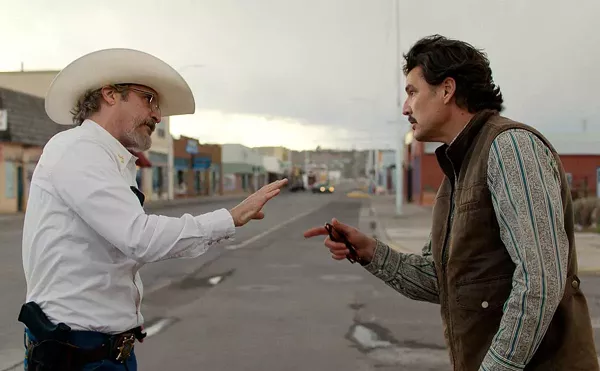
Audio By Carbonatix
[
{
"name": "GPT - Leaderboard - Inline - Content",
"component": "35519556",
"insertPoint": "5th",
"startingPoint": "3",
"requiredCountToDisplay": "3",
"maxInsertions": 100,
"adList": [
{
"adPreset": "LeaderboardInline"
}
]
}
]
In the tiny village of Hauterives in southeastern France, surrounded by nothing but rural land, in 1879, a postman named Ferdinand Cheval began building a visionary work of art called the Palais Idéal. He would spend the next 34 years stuffing his pockets with stones from the road to create a surrealistic château that looks like a cross between a Gaudi church and a Hindu temple.
In his autobiography, published in Raw Vision magazine, Cheval, a peasant's son, wrote by way of an explanation:
"Constantly walking in the same surroundings, what could I do but dream?"
Reading that reminded me that I love Detroit because of all you Ferdinands who live here. You view buildings as vessels rather than "developments." You appreciate Detroit not just because of what it used to be or could be, but because the city has a special power and you feel plugged in. That's what you capitalize on. You recognize that far too many of our architects and urban planners — supposedly creative thinkers — are dreaming up lofts and paving over green space. And in the absence of globally minded government leaders, you consider artists visionaries. You literally take matters into your own hands, rebuilding your home or your neighborhood. In the scorched earth, you see potential for life to flourish again.
Take Olayame Dabls, for instance. The owner of the African Bead Museum, located on Grand River Avenue at Vinewood, Dabls recently bought an adjacent 17,000-square-foot building. The city told him to board it up, so he did. He boarded it up with thousands of shards of mirrored glass and pieces of iron and wood. The N'kisi Iron House is a protector. An image of evil can't penetrate the perimeter; it merely bounces off the surface. Like a giant bejeweled quilt hung across the landscape, the exterior reflects a moving picture of people bustling out of church and trees rustling. The structure comes alive when all that metal dances and sings in the evening wind.
"Art like this you can't grant out or legislate," Dabls says. "It cannot be designed somewhere else and then 'unveiled.'" He works on the structure every day, from the time he gets up till he feels finished, while his friend Efe plays the drums. "It's a testament to the community that people respect it." The only time either of his buildings was damaged, he says, was when a boy threw a bottle merely to prove to his friend the building really is made with glass. Dabls asked him to return the following day and repair it, and the boy did.
Over the years, I've chronicled other outdoor art projects like Dabls'; I've written about street performances, sculptures, installations, environments and more. Sylvia Burke's garden of ornamented ghetto palms, the Heidelberg Project, Hamtramck Disneyland, the socially minded stenciling of an artist named SOS. Not to mention the anonymous crew that dropped blue flags from the windows of Michigan Central Station, and the guerrilla house painters of the Object Orange collective. Albeit with different intentions, these people have one thing in common: an understanding that art is not just an object or an idea, but a place that the spirit calls home.
While they have been taking action in the streets, another movement has been brewing in Detroit. Inside boardrooms and corporate offices, groups like Detroit Renaissance and the University Cultural Center Association have been raising funds to beautify the city, and public art seems to be a natural extension of that.
The idea is to make the area a more culturally and economically viable area, attracting new residents and investors. The word "creative" gets tossed around a lot — usually in reference to industries of advertising, design, technology and media. Detroit Renaissance's estimated $50 million Creative Corridor project, part of its Creative Economy venture, is an attempt to connect pockets of activity on Woodward Avenue, from downtown to New Center. (The Woodward Avenue light rail line, which seems to be moving forward, will be an enormous step toward the same goal.)
"One component of that is public art," says Sabrina Keeley, vice president of Detroit Renaissance. She has selected a group of local leaders, including DIA Director Graham Beal, for guidance.
The Downtown Detroit Partnership, a private-public partnership of such corporate and civic leaders as Detroit Economic Growth Corporation and the mayor's office, is currently involved in cataloging and restoring existing public works. President and CEO Ann Lang says the partnership has considered plans for additional art: "There has been other conversation, but nothing is yet well-developed." Other associations, such as the Detroit RiverFront Conservancy and Belle Isle Women's Committee, have their own agendas focusing on improvement with an eye toward public art.
The University Cultural Center Association, spearheaded by Sue Mosey, has designed the most extensive public art plan as part of the Midtown Loop, a 1.8-mile pedestrian-friendly greenway that designates a dozen sites for outdoor art.
While these are noble efforts at nurturing homegrown talent, they ask art to fit in a prescribed mold in service of something else — revamping commercial business districts and enhancing the appeal of manicured civic spaces. But what about art that springs from some more spontaneous impulse, art that's ephemeral or can't so conveniently be contained? What about art that isn't plunked down on the ground but rather rises from its surroundings?
Those in charge at the Detroit Institute of Arts three decades ago sure weren't ready for that kind of art. Influential contemporary curator Sam Wagstaff commissioned Michael Heizer to create an earthwork, and the artist dragged 30-some tons of stone across the north lawn to etch out a drawing in the lawn. The execution literally hit a snag (underground cables) and the ensuing brouhaha set back such public art here for years. Aside from a proposed venture at the Museum of Contemporary Art Detroit — an installation by former Detroiter and art star Mike Kelly that's a full-scale replica of his Westland childhood home — our institutions have generally proved they lack vision and courage when it comes to truly immersive art experiences in the public realm.
This is not to diminish the majestic outdoor monuments and sculptures that we already have (take a gander at Dennis Nawrocki's new third edition of Art In Detroit Public Places, published by Wayne State University Press). But we need a public art fund that commissions major contemporary projects beyond the conservative traditions of public art. And it needs to happen everywhere — in the urban center and in remote locations across the city. Detroit is 140 square miles big.
The Public Art Fund in New York City is an excellent model for a program we can truly make our own. "We are a museum without walls," explains Rochelle Steiner, its director. The 31-year-old nonprofit was founded by Doris C. Freedman, New York's first director of cultural affairs. However, PAF is not, nor has it ever been, a city organization. In fact, it receives very little support from government — only 3 percent of its $3 million annual budget — which frees the fund from political motivations and maneuvering. In some ways, it's akin to the Whitney Museum or Guggenheim, Steiner says, but with nearly 500 square miles worth of space.
"In one way or another, we stretch the notion of what public art is, how it can be street performance, film, not necessarily sculpture."
PAF is not a grant-giving agency. It commissions works by established international artists and accepts proposals from emerging local artists. In addition, PAF presents public discussions.
The group's most recent project is renowned Danish-born artist Olafur Eliasson's "New York City Waterfalls," an approximately $15 million project consisting of four man-made waterfalls installed at sites along the shores of Manhattan, Brooklyn and Governor's Island. Eliasson honors the iconic skyline by drastically altering the way it's perceived. "He's responding to the particularity of the East River," says Steiner. Nature's masterpiece is a revelation in the urban context.
"It required an extraordinary number of permits, and we achieved all of them," Steiner says. "Culture matters here. It's at the heart of the city, and organizations have been seeking permits for many years, so it's not a total anomaly when you go to the building department and get a permit."
I'm by no means arguing that we shape our city after theirs. Detroit, after all, produces some of the most down-to-earth yet savvy people in the country, which may be the real reason we are still the major city most outside of mainstream American consumer culture. We have not been locked into the direction of the rest of the country.
What I'm saying is there has to be a clear-eyed evaluation of Detroit's actual assets, and two big ones are our artists and our land. An initiative such as this would, first off, be tailored to supporting the activities of people who actually live here. It would lead by example, proving that local public art projects are, as Heidelberg's Tyree Guyton says, "medicine" for the community. Second, it would allow Detroiters to experience world-class art in inconspicuous places, on grounds they feel familiar with, for free. Plus, welcoming internationally known artists to interact with our environment is a smart move that teaches artists (who have influence in shaping culture and are more likely to listen) to value our region's natural resources and to learn more about our rich history.
So where would Detroit get ground-floor funding for such an expensive idea? PAF relies on support from board members and private donors. Steiner says, "The board consists of people who have the qualifications to make the decisions in terms of who we think are important, relevant artists."
Detroit arts patron Marc Schwartz is one such person. The world-renowned print collector is on the Board of Directors of the Detroit Institute of Arts, Cranbrook Academy of Art & Art Museum and ArtServe Michigan. For several years now, he has been advocating an outdoor installation by a world-renowned artist that would transform the local landscape.
"Detroit, through misfortune, has one natural resource which every other major city in the world except for Paris, with its extensive parks system, covets: land space. It allows for many opportunities transforming the land or placing objects on it. Working with vacant land in some manner is probably the least expensive way to make transformation. You could change the city landscape more cost effectively than a $20 million building could."
Schwartz continues: "I do believe a public art fund could have a big impact. Based upon conversations that I've had with major arts-supporting foundations, institutions and nonprofits, I think there would be significant support. I also think there are some opportunities for some private initiatives."
If local government needs convincing of the potential economic impact, proof is in the numbers of the best-known public art project in recent American history. New York artists Christo and Jeanne-Claude realized their "Gates Project" in Central Park on Feb. 12-27, 2005. Entirely at their own expense, the artists paid for the labor and materials to install orange banners on the park grounds, set off against the winter-white landscape. They hired 300 city employees and donated $3 million from souvenir sales to the city for programs and operations in parks.
Initial data from a report by Mayor Michael Bloomberg's office indicated that the project attracted more than 4 million visitors to the area — in addition to the typical draw — and generated an estimated $254 million in economic activity.
"The impact was felt in restaurants, hotels and cultural institutions across the city," Bloomberg's report announced. For example, lunch business at Mickey Mantle's, a restaurant and sports bar in the Central Park south neighborhood, doubled on weekdays and tripled on weekends, according to the report.
Locally, tourists from across the country and overseas already flock to an art project in the heart of one of our most economically depressed neighborhoods. The Heidelberg Project's outdoor installation receives 275,000 visitors annually, according to their brochures. During Heidelberg's summer festival a few weeks ago, a homeowner on Mt. Elliot turned her residence into a bed and breakfast, and "big-earring, gum-popping bootie ladies were talking to CEOs," says Jenenne Whitfield, Heidelberg's executive director. "This is a community at work."
Currently Whitfield, along with Heidelberg's board of directors, is working to raise money for the House That Makes Sense, as well as other residences that would facilitate artists staying on-site, embedding themselves in the community experience.
"Attracting cool to the city — that notion is so tired. I'm so sick of that class of people who need to be massaged to live here. We give far too much credit to those folks. This city has never understood who we are or what we have here. We need to wake up the neighborhoods, shake the city up," says Whitfield.
Local artist Scott Hocking sees things similarly.
"Every time I get a visitor from out of town, they talk about wanting to do a project here," he says. He has been creating large-scale outdoor installations in Detroit for about five years, including a pyramid made from 2,109 used tires, which he erected on the front lawn of Julie and Robert Taubman's Bloomfield Hills home, as part of a Museum of Contemporary Art Detroit fundraiser. (His original site at an abandoned trailer park near City Airport didn't work out.) Recently Hocking constructed a ziggurat of bricks inside the Fisher Body Plant. His future plans include creating a "pallethenge" (a play on the ancient, monumental Stonehenge) from hundreds of wooden pallets left in a vacant lot near Highland Park. He's also considering mowing or flattening part of the field like crop circles at an abandoned bike-racing track off Mound Road (a photo of that field and Hocking's rendering are on MT's covers this issue).
"I feel like all artists would love to have grants, but right now nobody will pay you to go into a building and stack blocks all day. I want to do work that speaks to Detroit history, the heart of the place, and so often public art just misses the mark when it's for the masses — like those dumb-ass fiberglass animals [in downtown Chicago in 1999]. Before I became an artist I was an average Joe who made fun of that stuff. It just fuels the fire."
Hocking's installations reference Detroit's ancient history. He's researched mounds crafted by Native Americans during the late Woodland period, circa A.D. 500-1300, in order to construct modern versions. Several dozen ancient mounds are believed to have been used as burial grounds and for decorative and ceremonial purposes in this area. The Native Americans who settled here later believed the mounds to be sacred, without knowing who built them, but most of the mounds were leveled when European settlers transformed Detroit as an agricultural town.
"There were mounds right where the Rouge River meets the Detroit River, on the Detroit side," Hocking says.
"The two largest mounds were right near the Detroit River, south of Jefferson and east of Rouge, and the one that was closest to the river was conical in shape, and estimated to be about 50 feet tall and 300 feet in diameter, but it was eroded by cattle. Now there's a giant brownfield there. Southwest Delray was heavy with native sites too, but the only evidence is on Fort Wayne. They do have a small mound they've preserved, but it's very small and fenced off and so overgrown you can't really see it anymore."
His ideas tap into that psychic energy of the city, driving him to uncover the landscape's hidden potential. "There's something that I feel drawn to in a spiritual sense, and over time I've wanted to discover that and delve into it. Thresholds or transition states are interesting, mysterious moments — dusk or dawn, or the transitions in your life. Detroit has that sense of strangeness."
Touring Detroit at night, you can sense what Hocking's talking about. So many spots in this city seem as if they represent civilization's absence; we refer often to "empty" lots and "abandoned" buildings as our burial grounds of industrialization and capitalist enterprises. But that land bears centuries of footprints. Long ago, those who lived here believed in the intense influence of physical contact with nature — it was the very definition of existence. Maybe that's what is felt in tremors below the surface. The layers of "progress" have been peeled back. And like Whitfield says, now it's time to wake up the neighborhood, and let the rules change.
Rebecca Mazzei is Metro Times arts and culture editor. Send comments to rmazzei@metrotimes.com




